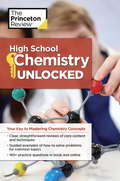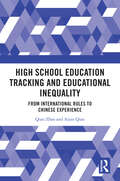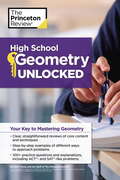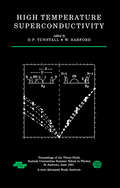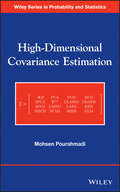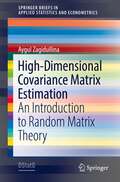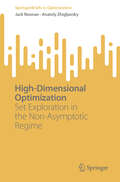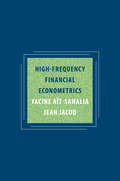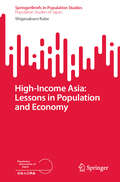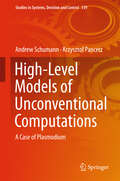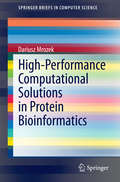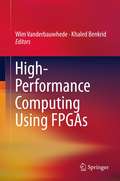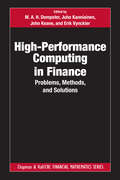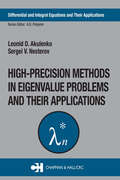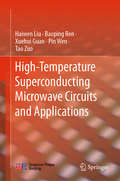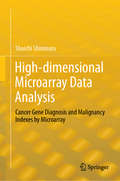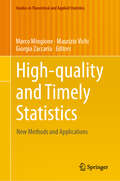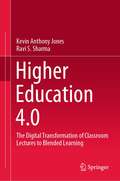- Table View
- List View
High School Chemistry Unlocked: Your Key to Understanding and Mastering Complex Chemistry Concepts (High School Subject Review)
by The Princeton ReviewUNLOCK THE SECRETS OF CHEMISTRY with THE PRINCETON REVIEW.High School Chemistry Unlocked focuses on giving you a wide range of key lessons to help increase your understanding of chemistry. With this book, you'll move from foundational concepts to complicated, real-world applications, building confidence as your skills improve. End-of-chapter drills will help test your comprehension of each facet of chemistry, from atoms to alpha radiation. Don't feel locked out!Everything You Need to Know About Chemistry.• Complex concepts explained in straightforward ways• Walk-throughs of sample problems for all topics• Clear goals and self-assessments to help you pinpoint areas for further review• Guided examples of how to solve problems for common subjectsPractice Your Way to Excellence.• 165+ hands-on practice questions, seeded throughout the chapters and online• Complete answer explanations to boost understanding• Bonus online questions similar to those you'll find on the AP Chemistry Exam and the SAT Chemistry Subject TestHigh School Chemistry Unlocked covers:• Building blocks of matter• Physical behavior of matter• Chemical bonding• Chemical reactions• Stoichiometry• Solutions• Acids and bases• Equilibrium• Organic chemistry• Radioactivity... and more!
High School Education Tracking and Educational Inequality: From International Rules to Chinese Experience
by Qian Zhao Ajian QianThe book focuses on educational tracking at the high school level and explores its impact on educational inequality.By constructing an analytical framework that combines macro and micro perspectives, the authors aim to provide a thorough analysis of the impact of educational tracking on inequality, offering new empirical evidence for international research on educational and social stratification. By revealing the institutional characteristics and unequal effects of high school educational tracking, the book provides empirical support for optimizing China’s educational tracking policy and advancing the goal of educational equity.The book will appeal to scholars and students of educational tracking, educational equity, and comparative education.
High School Geometry Unlocked
by Princeton ReviewThis eBook edition has been specially formatted for on-screen viewing with cross-linked questions, answers, and explanations.UNLOCK THE SECRETS OF GEOMETRY with THE PRINCETON REVIEW.Geometry can be a daunting subject. That's why our new High School Unlocked series focuses on giving you a wide range of key techniques to help you tackle subjects like Geometry. If one method doesn't "click" for you, you can use an alternative approach to understand the concept or problem, instead of painfully trying the same thing over and over without success. Trust us--unlocking geometric secrets doesn't have to hurt!With this book, you'll discover the link between abstract concepts and their real-world applications and build confidence as your skills improve. Along the way, you'll get plenty of practice, from fully guided examples to independent end-of-chapter drills and test-like samples. Everything You Need to Know About Geometry.* Complex concepts explained in clear, straightforward ways* Walk-throughs of sample problems for all topics* Clear goals and self-assessments to help you pinpoint areas for further review* Step-by-step examples of different ways to approach problems Practice Your Way to Excellence.* Drills and practice questions in every chapter* Complete answer explanations to boost understanding* ACT- and SAT-like questions for hands-on experience with how Geometry may appear on major examsHigh School Geometry Unlocked covers:* translation, reflection, and rotation* congruence and theorems* the relationship between 2-D and 3-D figures* trigonometry* circles, angles, and arcs* probability* the algebra-geometry connection... and more!
High School Math Solution, Algebra II, Volume 1
by Sandy Bartle Finocchi Amy Jones Lewis Josh Fisher Janet Sinopoli Victoria FisherNIMAC-sourced textbook
High School Math Solution, Algebra II, Volume 2
by Sandy Bartle Finocchi Amy Jones Lewis Josh Fisher Janet Sinopoli Victoria FisherNIMAC-sourced textbook
High School Math Solution, Geometry
by Sandy Bartle Finocchi Amy Jones Lewis Josh Fisher Janet Sinopoli Victoria FisherNIMAC-sourced textbook
High School Math Solution, Integrated Math III, Volume 1
by Sandy Bartle Finocchi Amy Jones Lewis Josh Fisher Janet Sinopoli Victoria FisherNIMAC-sourced textbook
High School Math Solution, Integrated Math III, Volume 2
by Sandy Bartle Finocchi Amy Jones Lewis Josh Fisher Janet Sinopoli Victoria FisherNIMAC-sourced textbook
High Temperature Superconductivity (Scottish Graduate Ser. #39)
by D P TunstallHigh Temperature Superconductivity provides a broad survey of high temperature superconductivity, discussing the adaptations of experimental and theoretical techniques and methods that take advantage of the revolutionary properties of high temperature superconductors. Distinguished engineers, chemists, and experimental and theoretical physicists introduce their own particular area of the field before going on to explain current theories and techniques. The book is divided into three sections: materials, mechanisms, and devices. Topics covered include synthetic approaches to the growth of new materials; optical, magnetic, and electrical characterization of synthesized materials; strong correlations; the magnon pairing mechanism; and technical background of device performance in new materials. A coherent introduction to high temperature superconductivity, this volume will be invaluable to researchers in condensed matter physics, chemistry, materials science, and engineering.
High-Dimensional Covariance Estimation
by Mohsen PourahmadiMethods for estimating sparse and large covariance matricesCovariance and correlation matrices play fundamental roles in every aspect of the analysis of multivariate data collected from a variety of fields including business and economics, health care, engineering, and environmental and physical sciences. High-Dimensional Covariance Estimation provides accessible and comprehensive coverage of the classical and modern approaches for estimating covariance matrices as well as their applications to the rapidly developing areas lying at the intersection of statistics and machine learning.Recently, the classical sample covariance methodologies have been modified and improved upon to meet the needs of statisticians and researchers dealing with large correlated datasets. High-Dimensional Covariance Estimation focuses on the methodologies based on shrinkage, thresholding, and penalized likelihood with applications to Gaussian graphical models, prediction, and mean-variance portfolio management. The book relies heavily on regression-based ideas and interpretations to connect and unify many existing methods and algorithms for the task.High-Dimensional Covariance Estimation features chapters on:Data, Sparsity, and RegularizationRegularizing the EigenstructureBanding, Tapering, and ThresholdingCovariance MatricesSparse Gaussian Graphical ModelsMultivariate RegressionThe book is an ideal resource for researchers in statistics, mathematics, business and economics, computer sciences, and engineering, as well as a useful text or supplement for graduate-level courses in multivariate analysis, covariance estimation, statistical learning, and high-dimensional data analysis.
High-Dimensional Covariance Matrix Estimation: An Introduction to Random Matrix Theory (SpringerBriefs in Applied Statistics and Econometrics)
by Aygul ZagidullinaThis book presents covariance matrix estimation and related aspects of random matrix theory. It focuses on the sample covariance matrix estimator and provides a holistic description of its properties under two asymptotic regimes: the traditional one, and the high-dimensional regime that better fits the big data context. It draws attention to the deficiencies of standard statistical tools when used in the high-dimensional setting, and introduces the basic concepts and major results related to spectral statistics and random matrix theory under high-dimensional asymptotics in an understandable and reader-friendly way. The aim of this book is to inspire applied statisticians, econometricians, and machine learning practitioners who analyze high-dimensional data to apply the recent developments in their work.
High-Dimensional Optimization: Set Exploration in the Non-Asymptotic Regime (SpringerBriefs in Optimization)
by Anatoly Zhigljavsky Jack NoonanThis book is interdisciplinary and unites several areas of applied probability, statistics, and computational mathematics including computer experiments, optimal experimental design, and global optimization. The bulk of the book is based on several recent papers by the authors but also contains new results. Considering applications, this brief highlights multistart and other methods of global optimizations requiring efficient exploration of the domain of optimization. This book is accessible to a wide range of readers; the prerequisites for reading the book are rather low, and many numerical examples are provided that pictorially illustrate the main ideas, methods, and conclusions. The main purpose of this book is the construction of efficient exploration strategies of high-dimensional sets. In high dimensions, the asymptotic arguments could be practically misleading and hence the emphasis on the non-asymptotic regime. An important link with global optimization stems from the observation that approximate covering is one of the key concepts associated with multistart and other key random search algorithms. In addition to global optimization, important applications of the results are computer experiments and machine learning. It is demonstrated that the asymptotically optimal space-filling designs, such as pure random sampling or low-discrepancy point nets, could be rather inefficient in the non-asymptotic regime and the authors suggest ways of increasing the efficiency of such designs. The range of techniques ranges from experimental design, Monte Carlo, and asymptotic expansions in the central limit theorem to multivariate geometry, theory of lattices, and numerical integration. This book could be useful to a wide circle of readers, especially those specializing in global optimization, numerical analysis, computer experiments, and computational mathematics. As specific recipes for improving set exploration schemes are formulated, the book can also be used by the practitioners interested in applications only.
High-Dimensional Probability: An Introduction with Applications in Data Science (Cambridge Series in Statistical and Probabilistic Mathematics #47)
by Roman VershyninHigh-dimensional probability offers insight into the behavior of random vectors, random matrices, random subspaces, and objects used to quantify uncertainty in high dimensions. Drawing on ideas from probability, analysis, and geometry, it lends itself to applications in mathematics, statistics, theoretical computer science, signal processing, optimization, and more. It is the first to integrate theory, key tools, and modern applications of high-dimensional probability. Concentration inequalities form the core, and it covers both classical results such as Hoeffding's and Chernoff's inequalities and modern developments such as the matrix Bernstein's inequality. It then introduces the powerful methods based on stochastic processes, including such tools as Slepian's, Sudakov's, and Dudley's inequalities, as well as generic chaining and bounds based on VC dimension. A broad range of illustrations is embedded throughout, including classical and modern results for covariance estimation, clustering, networks, semidefinite programming, coding, dimension reduction, matrix completion, machine learning, compressed sensing, and sparse regression.
High-Dimensional Statistics: A Non-Asymptotic Viewpoint (Cambridge Series in Statistical and Probabilistic Mathematics #48)
by Martin J. WainwrightRecent years have witnessed an explosion in the volume and variety of data collected in all scientific disciplines and industrial settings. Such massive data sets present a number of challenges to researchers in statistics and machine learning. This book provides a self-contained introduction to the area of high-dimensional statistics, aimed at the first-year graduate level. It includes chapters that are focused on core methodology and theory - including tail bounds, concentration inequalities, uniform laws and empirical process, and random matrices - as well as chapters devoted to in-depth exploration of particular model classes - including sparse linear models, matrix models with rank constraints, graphical models, and various types of non-parametric models. With hundreds of worked examples and exercises, this text is intended both for courses and for self-study by graduate students and researchers in statistics, machine learning, and related fields who must understand, apply, and adapt modern statistical methods suited to large-scale data.
High-Frequency Financial Econometrics
by Yacine Aït-Sahalia Jean JacodA comprehensive introduction to the statistical and econometric methods for analyzing high-frequency financial dataHigh-frequency trading is an algorithm-based computerized trading practice that allows firms to trade stocks in milliseconds. Over the last fifteen years, the use of statistical and econometric methods for analyzing high-frequency financial data has grown exponentially. This growth has been driven by the increasing availability of such data, the technological advancements that make high-frequency trading strategies possible, and the need of practitioners to analyze these data. This comprehensive book introduces readers to these emerging methods and tools of analysis.Yacine Aït-Sahalia and Jean Jacod cover the mathematical foundations of stochastic processes, describe the primary characteristics of high-frequency financial data, and present the asymptotic concepts that their analysis relies on. Aït-Sahalia and Jacod also deal with estimation of the volatility portion of the model, including methods that are robust to market microstructure noise, and address estimation and testing questions involving the jump part of the model. As they demonstrate, the practical importance and relevance of jumps in financial data are universally recognized, but only recently have econometric methods become available to rigorously analyze jump processes.Aït-Sahalia and Jacod approach high-frequency econometrics with a distinct focus on the financial side of matters while maintaining technical rigor, which makes this book invaluable to researchers and practitioners alike.
High-Income Asia: Lessons in Population and Economy (SpringerBriefs in Population Studies)
by Shigesaburo KabeThis book focuses on the high-income Asia that experienced fast economic growth and rapid demographic change in recent decades. High-income Asia includes Japan, South Korea, Taiwan, Singapore and Hong Kong, according to the World Bank&’s category classification. These economies enjoyed a brief period of brilliant economic growth but then faced a demographic shift, with the lowest fertility in the world. For example, Japan today must confront difficult challenges such as how to balance childbirth and childcare with women&’s employment as its population rapidly ages—a consequence that was hardly foreseen in the process of economic growth. The changing landscape is different at each stage of the process, and the issues related to economic growth cannot be clearly recognized before or during that growth. Therefore, as a reference for the future of developing countries, this book aims to provide positive and negative lessons, learned from high-income Asia&’s experiences in high-speed economic growth and demographic changes. First, it gives an overview of the rapid economic growth and demographic changes in high-income Asia over the past several decades. Then, among the challenges following economic growth, it focuses on two points: 1) how to balance childbirth and childcare with women&’s employment; and 2) how to respond to the anticipated labor shortage in the future. The former issue requires a delicate balance between preventing fertility decline and supporting women's employment. Here, a comparison among Japan, Taiwan and Korea is made. The latter question focuses primarily on Japan as the fastest-aging population in the world, with additional reference to parts of high-income Asia other than Japan, which also are aging. Based on analyses of these major points, the author discusses the policy implications for developing countries learned from the tough lessons of high-income Asia.
High-Level Models of Unconventional Computations: A Case Of Plasmodium (Studies in Systems, Decision and Control #159)
by Krzysztof Pancerz Andrew SchumannThis book shows that the plasmodium of Physarum polycephalum can be considered a natural labelled transition system, and based on this, it proposes high-level programming models for controlling the plasmodium behaviour. The presented programming is a form of pure behaviourism: the authors consider the possibility of simulating all basic stimulus–reaction relations. As plasmodium is a good experimental medium for behaviouristic models, the book applies the programming tools for modelling plasmodia as unconventional computers in different behavioural sciences based on studying the stimulus–reaction relations. The authors examine these relations within the framework of a bio-inspired game theory on plasmodia they have developed i.e. within an experimental game theory, where, on the one hand, all basic definitions are verified in experiments with Physarum polycephalum and Badhamia utricularis and, on the other hand, all basic algorithms are implemented in the object-oriented language for simulations of plasmodia. The results allow the authors to propose that the plasmodium can be a model for concurrent games and context-based games.
High-Performance Computational Solutions in Protein Bioinformatics
by Dariusz MrozekRecent developments in computer science enable algorithms previously perceived as too time-consuming to now be efficiently used for applications in bioinformatics and life sciences. This work focuses on proteins and their structures, protein structure similarity searching at main representation levels and various techniques that can be used to accelerate similarity searches. Divided into four parts, the first part provides a formal model of 3D protein structures for functional genomics, comparative bioinformatics and molecular modeling. The second part focuses on the use of multithreading for efficient approximate searching on protein secondary structures. The third and fourth parts concentrate on finding 3D protein structure similarities with the support of GPUs and cloud computing. Parts three and four both describe the acceleration of different methods. The text will be of interest to researchers and software developers working in the field of structural bioinformatics and biomedical databases.
High-Performance Computing Using FPGAs
by Khaled Benkrid Wim VanderbauwhedeHigh-Performance Computing using FPGA covers the area of high performance reconfigurable computing (HPRC). This book provides an overview of architectures, tools and applications for High-Performance Reconfigurable Computing (HPRC). FPGAs offer very high I/O bandwidth and fine-grained, custom and flexible parallelism and with the ever-increasing computational needs coupled with the frequency/power wall, the increasing maturity and capabilities of FPGAs, and the advent of multicore processors which has caused the acceptance of parallel computational models. The Part on architectures will introduce different FPGA-based HPC platforms: attached co-processor HPRC architectures such as the CHREC's Novo-G and EPCC's Maxwell systems; tightly coupled HRPC architectures, e.g. the Convey hybrid-core computer; reconfigurably networked HPRC architectures, e.g. the QPACE system, and standalone HPRC architectures such as EPFL's CONFETTI system. The Part on Tools will focus on high-level programming approaches for HPRC, with chapters on C-to-Gate tools (such as Impulse-C, AutoESL, Handel-C, MORA-C++); Graphical tools (MATLAB-Simulink, NI LabVIEW); Domain-specific languages, languages for heterogeneous computing(for example OpenCL, Microsoft's Kiwi and Alchemy projects). The part on Applications will present case from several application domains where HPRC has been used successfully, such as Bioinformatics and Computational Biology; Financial Computing; Stencil computations; Information retrieval; Lattice QCD; Astrophysics simulations; Weather and climate modeling.
High-Performance Computing in Finance: Problems, Methods, and Solutions (Chapman and Hall/CRC Financial Mathematics Series)
by M. A. H. Dempster, Juho Kanniainen, John Keane and Erik VynckierHigh-Performance Computing (HPC) delivers higher computational performance to solve problems in science, engineering and finance. There are various HPC resources available for different needs, ranging from cloud computing– that can be used without much expertise and expense – to more tailored hardware, such as Field-Programmable Gate Arrays (FPGAs) or D-Wave’s quantum computer systems. High-Performance Computing in Finance is the first book that provides a state-of-the-art introduction to HPC for finance, capturing both academically and practically relevant problems.
High-Precision Methods in Eigenvalue Problems and Their Applications
by Leonid D. Akulenko Sergei V. NesterovThis book presents a survey of analytical, asymptotic, numerical, and combined methods of solving eigenvalue problems. It considers the new method of accelerated convergence for solving problems of the Sturm-Liouville type as well as boundary-value problems with boundary conditions of the first, second, and third kind. The authors also present high
High-Temperature Superconducting Microwave Circuits and Applications
by Haiwen Liu Baoping Ren Xuehui Guan Pin Wen Tao ZuoHigh-temperature superconducting (HTS) materials are becoming more and more attractive in the context of designing RF/microwave filters because of their lower losses and excellent performance. This book focuses on the superconducting microwave filter and its application in modern communication. It first presents the basic principles, HTS materials and processing and then introduces several types of multi-band HTS bandpass filter (BPF), discussing their properties and analyzing equivalent circuit models and their performances. This book is a valuable resource for students and researchers who are interested in wireless communication and RF/microwave design.
High-dimensional Microarray Data Analysis: Cancer Gene Diagnosis and Malignancy Indexes by Microarray
by Shuichi ShinmuraThis book shows how to decompose high-dimensional microarrays into small subspaces (Small Matryoshkas, SMs), statistically analyze them, and perform cancer gene diagnosis. The information is useful for genetic experts, anyone who analyzes genetic data, and students to use as practical textbooks.Discriminant analysis is the best approach for microarray consisting of normal and cancer classes. Microarrays are linearly separable data (LSD, Fact 3). However, because most linear discriminant function (LDF) cannot discriminate LSD theoretically and error rates are high, no one had discovered Fact 3 until now. Hard-margin SVM (H-SVM) and Revised IP-OLDF (RIP) can find Fact3 easily. LSD has the Matryoshka structure and is easily decomposed into many SMs (Fact 4). Because all SMs are small samples and LSD, statistical methods analyze SMs easily. However, useful results cannot be obtained. On the other hand, H-SVM and RIP can discriminate two classes in SM entirely. RatioSV is the ratio of SV distance and discriminant range. The maximum RatioSVs of six microarrays is over 11.67%. This fact shows that SV separates two classes by window width (11.67%). Such easy discrimination has been unresolved since 1970. The reason is revealed by facts presented here, so this book can be read and enjoyed like a mystery novel. Many studies point out that it is difficult to separate signal and noise in a high-dimensional gene space. However, the definition of the signal is not clear. Convincing evidence is presented that LSD is a signal. Statistical analysis of the genes contained in the SM cannot provide useful information, but it shows that the discriminant score (DS) discriminated by RIP or H-SVM is easily LSD. For example, the Alon microarray has 2,000 genes which can be divided into 66 SMs. If 66 DSs are used as variables, the result is a 66-dimensional data. These signal data can be analyzed to find malignancy indicators by principal component analysis and cluster analysis.
High-quality and Timely Statistics: New Methods and Applications (Studies in Theoretical and Applied Statistics)
by Maurizio Vichi Marco Mingione Giorgia ZaccariaThis book addresses a wide range of recent methodological aspects, applications and best practices of statistics production. It comprises a selection of peer-reviewed contributions of methodological and applied interest presented at the 4th Conference of European Statistics Stakeholders, CESS 2022, held in Rome, Italy, on October 20-21, 2022. The first part discusses statistical methods with applications to environmental risk assessment, sentinels data, surveillance systems during the Covid-19 pandemic, healthcare risk management, the analysis of regional or structural changes of scale, household distributional accounts, regional rental prices on municipalities, the network topology of the Euro area interbank market, tourism statistics and big data, statistical literacy, and Sustainable Development Goal composite indicators for EU countries. The second part focuses on statistical methodologies for complex data analysis, namely the optimal number of clusters to rank a model-based index, clustering methods for asymmetric data using spectral approaches, a family of parsimonious matrix-variate mixture models for heavy-tailed data, the importance of robust second-stage regressions for financial data, and on perturbation methods. In view of the overarching theme “The European Data Ecosystem for the Statistical Information of the Digital Age” and the importance of statistical data for monitoring the progress of the United Nations’ Sustainable Development Goals, the CESS 2022 meeting provided a forum for discussion on methodologies, results, challenges and best practices among methodologists, producers, and users of European Statistics from academia, the national statistical offices and the institutions of the European Union. Chapter Estimating regional rental prices on LAU 2 municipalities in North Rhine-Westphalia is available open access under a Creative Commons Attribution 4.0 International License via link.springer.com.
Higher Education 4.0: The Digital Transformation of Classroom Lectures to Blended Learning
by Kevin Anthony Jones Sharma RavishankarThis book chronicles a 10-year introduction of blended learning into the delivery at a leading technological university, with a longstanding tradition of technology-enabled teaching and learning, and state-of-the-art infrastructure. Hence, both teachers and students were familiar with the idea of online courses. Despite this, the longitudinal experiment did not proceed as expected. Though few technical problems, it required behavioural changes from teachers and learners, thus unearthing a host of socio-technical issues, challenges, and conundrums. With the undercurrent of design ideals such as “tech for good”, any industrial sector must examine whether digital platforms are credible substitutes or at best complementary. In this era of Industry 4.0, higher education, like any other industry, should not be about the creative destruction of what we value in universities, but their digital transformation. The book concludes with an agenda for large, repeatable Randomised Controlled Trials (RCTs) to validate digital platforms that could fulfil the aspirations of the key stakeholder groups – students, faculty, and regulators as well as delving into the role of Massive Open Online Courses (MOOCs) as surrogates for “fees-free” higher education and whether the design of such a HiEd 4.0 platform is even a credible proposition. Specifically, the book examines the data-driven evidence within a design-based research methodology to present outcomes of two alternative instructional designs evaluated – traditional lecturing and blended learning. Based on the research findings and statistical analysis, it concludes that the inexorable shift to online delivery of education must be guided by informed educational management and innovation.
